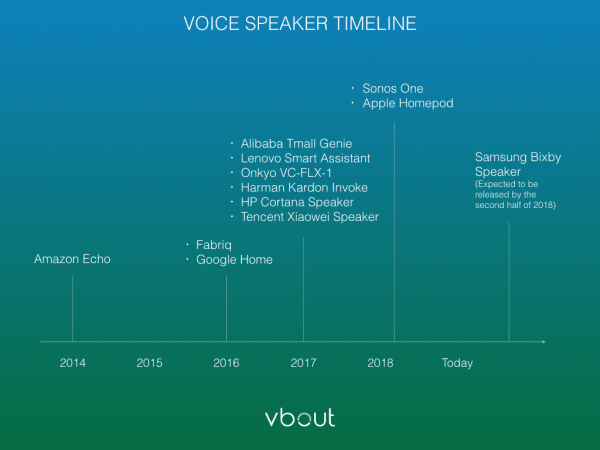When it comes to human speech, the average person can speak 150 words per minute, versus typing just 40 words in the same amount of time. This demonstrates a huge discrepancy between the way humans interact, and the technology used to communicate. Luckily, in the last 5 years, many companies have been quick to bridge that gap.
Voice, as an interface, is reshaping the way we think about the future of technology. Smart speakers are the current trend that’s gaining traction (and quickly) with many predicting that speakers will soon be used at the same frequency as tablets, phones, and smartwatches.
Amazon Alexa and Echo sales have shattered all estimates and records, Apple’s Siri is ubiquitous and the most widely used, and Samsung’s S Voice, Microsoft’s Cortana, and Google Home and Assistant are all major players in a game that may very well shape the way we think of technology as a whole. And with social media giants like Facebook throwing themselves into the fray with a set of smart speakers set to be released this summer, it’s clear that others are catching on.
And while many are quick to mistake voice-enabled technology as solely for consumer device companies, voice can be incorporated into marketing campaigns across the board. In short, we’re on the cusp of a voice technology revolution. Here are the few ways to get on board.
Make the experience feel easy
The term ‘easy’, in this case, is synonymous with seamless integration.
Technology that is ‘easy to use’ means that it has been designed with human needs and desires in mind; that it’s built to be intuitive to a person’s natural senses, lifestyle, and even anticipating what they might think or say next. While voice technology has been on the market for years—most notably with the phrase “Hey, Siri”—the tech is now trying to grasp the breadth and complexity of voice recognition when it comes to human behavior and emotion.
Whether you’re planning to create a voice assistant of your own, or if your plan is to integrate voice into your marketing strategy, the best approach is to facilitate an experience that feels, well, effortless. An audience that is already familiar with voice technology will be quick to notice any rips in the perceived seamlessness of your programming or your content.
Take note that we are still at the beginning stages of voice tech innovation. This means that the technology, no matter how sound it may seem, will inevitably morph over time. Monitor changes to the technology so that your efforts don’t lag behind.
Latch on to bigger brands
The bigger the brand, the more resources they will have at their disposal. As mentioned above, the major players in voice integration have already developed, or are on their way to developing speakers of their own. If building new tech is not on the agenda for your business, try looking to avenues that focus on affiliate marketing.
One example of this is Amazon’s Alexa and its smart home skill API. Alexa interprets customer utterances and sends messages to your skill that communicates these requests. Any company can upload a skill (known as a directive) to Alexa as long as they have a developer account (here’s more information on how to get one).
Alexa provides a couple of examples of what you can build with its program as an outside company:
- Add Capabilities to Alexa—the Alexa Skills Kit (ASK) is a collection of self-service APIs, tools, documentation, and code samples. Skills make Alexa smarter and enable customers to do more with voice. The aim is to build natural, voice-first experiences with their toolkit in order to redefine the way customers look at your brand.
- Integrate Alexa Into Your Device—the Alexa Voice Service (AVS) brings the hands-free voice control to any connected device. Through AVS, you can add a new interface to your products and offer customers access to a large number of Alexa features, smart home integrations, and skills.
- Connect Devices to Alexa—connecting Alexa to your devices can help build intuitive experiences for your customers. You can also build your own Alexa Gadgets or create interactive skills that work with Alexa Gadgets such as Echo Buttons.
In other words, this brand already has opportunities for other companies to work with them firmly in place. For the full range of voice speakers and their creation timeline, see below:

Problems are Inevitable
Given that the technology is still young, technical issues will inevitably arise. Think glitches and misconstrued words as a couple of issues that voice devices face daily. The majority of devices have found ways to correct any perceived mistakes smoothly, and almost imperceptible, but note that technical issues may still arise.
According to a recent study, 35% of issues reported account for normal recognition errors, with 31% being noise related and 22% being pronunciation related. Prepare for this by having a plan in place when dealing with both customers and businesses alike. Be helpful, be courteous, and understand your customer’s needs. While this practice almost goes without saying, troubleshooting will likely be a common practice.
And while information moves to the more ephemeral airspace between person and speaker, data, and the monitoring of said data, is changing along with it. Your SEO strategy will need to be malleable in order to keep up with the switching technologies. As we move progressively away from digital, the way your site or program ranked with will monitored in a variety of different ways. Make your content direct and even conversational to match the types of search queries that people will search for.
While this is more of a prediction than a fact grounded in stats: voice technology will slowly, but surely, replace digital. Touchscreens will slowly become obsolete in the next generation, with typing—much like freehand writing today—being a skill that is rarely practiced. With companies just beginning to bring their technological explorations to market, keep voice interfaces at the forefront of your mind in order to stay ahead of the curb. In addition, make sure to stay on top of all of 2019’s exciting trends.
Don’t forget to share this article


